Available Products
(If you do not see a Product you are looking for, please Contact Us for more information)
| Texas TURBO Triplanar Control AFO
This variation of the floor reaction AFO offers exceptional triplanar control with less surface contact than other designs, making it lighter weight and cooler. The secret is a polypropylene reinforcing strut that runs the length of the AFO from the medial arch up the leg, then back down to the lateral border of the heel. This offers significant rigidity for triplanar control. This is armor for the ankle. This is by far the most popular design we make for the adult population and the outcomes are better than with any other design we fabricate. The anterior shell captures the tibia better than posterior designs. We feel this helps to control tibial rotation. Medial and lateral trimlines extend anterior to midline at the ankle. A long lateral forefoot trim limits forefoot abduction, when indicated, and a well molded, padded footplate comfortably controls foot motion. The Texas TURBO is indicated in most situations where a standard floor reaction or solid AFO is indicated- including all diagnoses that require triplanar control. Some very applicable diagnoses are: Posterior Tibial Tendon Dysfunction, chronic Achilles Tendinitis, Osteoarthritis, Chronic, acute Plantar Fasciitis, and more. This design is comparable to rigid carbon fiber AFOs on the market, but posesses the adjustability and price point that comes with polypropylene. For more information, click here. This low profile design limits motion in the foot/ankle complex |
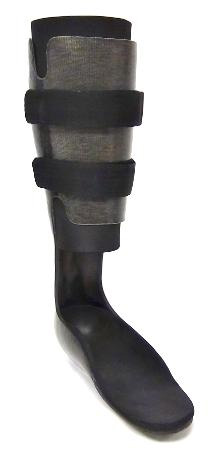 |
|
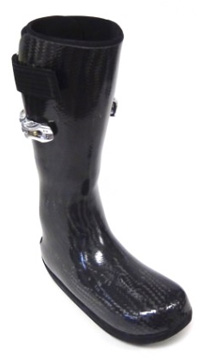 |
LoadShifter AFO
This design is capable of removing form 0 to100% of the weight from the distal tibia, talus and calcaneus, through the donning technique. This design uses hydrostatic compression of soft tissue, with introduced friction of overlapping liner. They are laminated with carbon fiber posteriorly and a flexible lamination anteriorly. This layup gives us the required rigidity for loading and the flexibility for variable loading. There is no other design we are aware of in the world that accomplishes this. There is a limited patient population this design is indicated for. Some applicable diagnoses are avascular necrosis of the talus, comminuted fractures of the talus, calcaneus or distal tibia, osteomyelitis and chronic wounds. |
|
|
LoadShifter AFO, Neuropathic
This is the neuropathic version of our LoadShifter line. When a patient has edema, is insensate, has a wound or other condition that precludes the use of footwear, this is the design we use and recommend. Laminated with carbon fiber this is the lightest weight neuropathic walker available. |
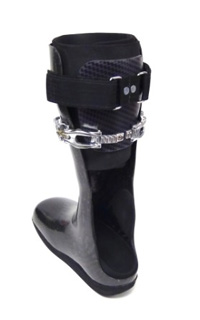 |
|
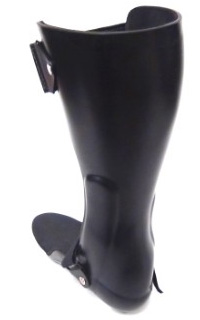 |
Solid Ankle AFO The solid ankle AFO is the most prescribed plastic AFO design. It is indicated when motion needs to be limited or controlled. It may be used in adults in the treatment of conditions such as PTTD, arthritis, achilles tendonitis, fractures, severe plantar fasciitis, and more. This is a lightweight, custom-molded design which supports the lower leg in cases involving ankle and/or weakness or spasticity. They are also the most prescribed design for children with disabilities. The trimlines can be manipulated to control motionCan be modified to reduce tone or maintain neutral alignment and can minimize varus/valgus with the addition of a dynamic force strap. This brace is worn inside of a shoe, which may require a larger size or extra depth shoe. We tend to recommend the Texas Turbo design rather than this one, however some physicians and patients prefer this design as it is easier to don. |
|
Hinged AFO
There are many different designs of hinged AFOs with a variety of hinges and flexion stops. The goal of the hinged AFO is to allow desired motion while preventing any unwanted motion. The brace may allow for full range of plantarflexion/dorsiflexion or may block plantar flexion at almost any degree with the use of a plantarflexion stop. This dynamic design offers added stability, limits valgus and varus motion and can be modified to correct adduction/abduction issues of the forefoot. These orthoses can be further customized by using different plastic trimlines, straps, thickness of plastic, and durometer (resistance) of joints. Any specific kind of hinged AFO may be prescribed to a patient depending on that patient's capabilities, disabilities, deficits, daily activities and prognosis. This is a very popular design for our pediatric population. This brace is worn inside of a shoe, which may require a larger size or extra depth shoe. |
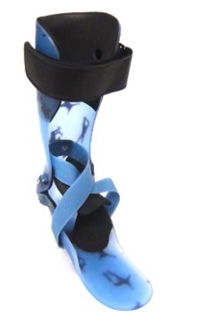 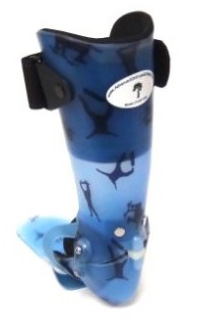 |
| |
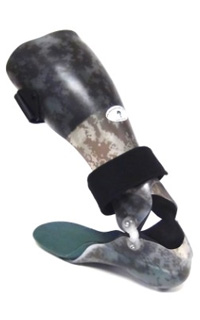 |
Dorsiflexion Assist AFO
There are many different designs of hinged AFOs with a variety of hinges and flexion stops. The Dorsiflexion Assist AFO is commonly used in patients with drop foot— the limited ability or inability to lift the foot (dorsiflex) at the ankle joint. The goal of this AFO is to aid in dorsiflexion and still allow the patient to plantarflex as much as is desired. The brace may allow for full range of plantarflexion/dorsiflexion or may block plantarflexion at almost any degree with the use of a plantarflexion stop. These braces can be customized by using different plastic trims, straps, thickness of plastic, and durometer of joints. This brace is worn inside of a shoe, which may require a larger size or extra depth shoe. |
|
Posterior Leaf Spring AFO (PLS AFO)
This is a very dynamic design used most often to treat weak dorsiflexors of the foot; such as in drop foot, peroneal palsy, and in some cases Charcot-Marie-Tooth disease. This design allows limited plantarflexion at heel strike, provides good mediolateral stability in stance, facilitates toe clearance in the swing phase of gait, and gives good plantar proprioceptive feedback. The braces trimlines run posterior to the malleoli, creating a narrow/flexible posterior aspect to the brace and 3-5 degrees of dorsiflexion is usually built in. However, due to the high flexibility of this design, the PLS AFO does not control subtalar eversion, midtarsal pronation, and forefoot abduction as well as some other plastic AFOs. This brace is in full contact with the leg, which can reduce the occurrence of pressure points by more evenly distributing contact forces, however due to the custom fit of the brace it may not be used with fluctuating edema. This brace is worn inside of a shoe, which may require a larger size or extra depth shoe. |
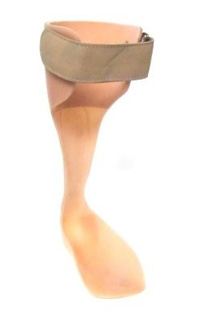 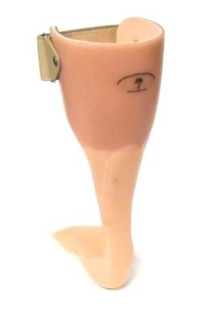 |
|
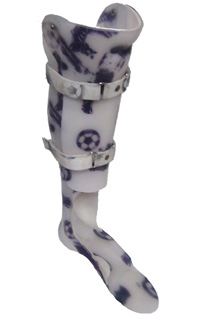 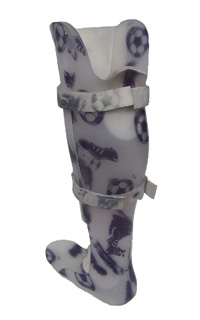 |
Patellar Tendon Bearing AFO (PTB AFO)
The PTB AFO is designed to transfer weight from the foot/ankle complex to the patella tendon as well as to the calf area through hydrostatic compression. This may be prescribed to treat chronic or acute conditions of the foot/ankle where weight bearing is contraindicated. When fabricated correctly this design can unload as much as 90% of the load typically borne the distal tibia, talus and heel. This is a very difficult design to fabricate and very few practitioners can fabricate it properly. By using a "cut & separate" technique we raise the belly of the calf in the brace by 1/2", causing the patient's calf to be held 1/2" higher through hydrostatic compression which will not allow the heel to fully touch bottom. Over time there will be volume changes which may necessitate 3 or 5 ply socks to the calf area or the addition of extra padding. This AFO can be made in a full plastic design as shown here or can be made with metal uprights/joints and attached to a shoe. The full plastic version is worn inside of a shoe, which may require a larger size or extra depth shoe. |
|
Wraparound AFO
This design functions similarly to the PTB AFO design and we cut and separate the cast just as we do for PTBs. This orthosis relies solely on hydrostatic compression of soft tissue to unweight the distal tibia, talus, and calcaneous. In this design we use very thin polypropylene and modify the model for total contact, the proximal trimlines end approximately 1.5" below the head of the fibula. This design fits in most shoes and can be as effective as, or more effective than, a PTB AFO— although they are not as durable as PTB AFOs. Due to the wraparound trimlines of this design the brace can be difficult to don/doff and so patient education and selection are important. This brace is worn inside of a shoe, which may require a larger size or extra depth shoe. |
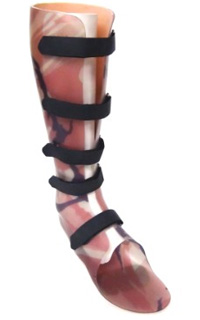 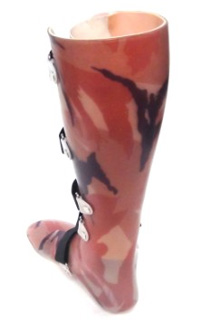 |
|
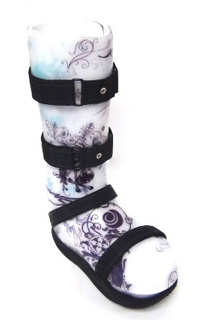 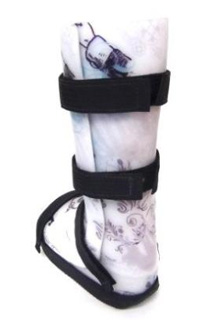 |
Charcot Restraint Orthotic Walker
The Charcot Restraint Orthotic (CRO) Walker is prescribed for patients with foot ulcers, loss of peripheral sensation, or severe deformities of the lower extremity, due to a neuropathic arthropathy— usually caused by diabetes. The inside of the brace is fully lined with protective padding and supports and protects the extremity. It functions similar to a cast, but is removable for wound care of observation. The clamshell design makes the brace easy to don/doff and there is a walking sole attached to the bottom of the CROW since this brace is too large to be worn with a shoe. Following treatment with a CROW some patients can begin to wear extra-depth shoes with custom inserts to accommodate any residual deformities, although not all patients will be able to return to standard footwear. |
|
Low Profile Hinged AFO (Richie Brace)
This design is often used in the treatment of tarsal coalition, early charcot arthropathy, severe ankle arthritis, lateral ankle instability, peroneal tendinopathy, and more. Although the SMAFO may be used to treat some of the same conditions, this design is more popular in the adult population. This brace uses a fully padded medial and lateral wing, leaving the anterior and posterior aspects open, which allows increased comfort and breathability. An optional strut could connect the medial and lateral wings posteriorly, increasing stability and control. A functional foot orthotic is built into the brace, and the heel is posted. This brace is worn inside of a shoe, which may require a larger size or extra depth shoe. |
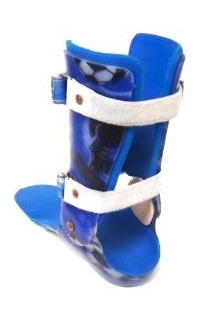 |
|
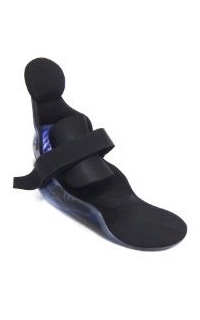 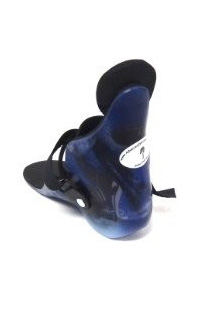 |
Supramalleolar AFO (SMO/SMAFO)
This is a low profile design used primarily in children but can also be used effectively in adults. These are typically used to treat varus/valgus deficiencies of the ankle, pes planovalgus, hypotonia and toe-walking in children (with the addition of a plantarflexion block). The SMO is designed to maintain a neutral heel and support the three arches of the foot. This low profile design is popular with physical therapists who prefer minimal intervention as it doesn't interfere much with muscular function. This brace is usually fabricated with a posted heel. This brace is worn inside of a shoe, which may require a larger size or extra depth shoe. |
|
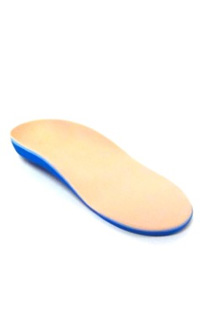  |
Trilaminar Diabetic Insert
These custom fabricated inserts are made using a three layered foam with a supportive base layer, a shock absorbing middle layer, and a very soft top layer. This material is ideal for those with very sensitive feet, in particular diabetics. They can be fit to nearly any orthopedic, casual, or athletic shoe. |
|
UCB/UCBL
The UCBL fits below the ankle and is typically used to correct calcaneal alignment and support the arches of the foot. It is mainly ordered for pes planovalgus, talocalcaneal varus, or (with special trimlines) metatarsus ab/adductus, but may also be used to treat the hypotonic foot as seen in many Down's Syndrome patients. Due to the rigidity of the orthosis, this design can only be used to correct flexible foot deformities. Any attempt to correct a rigid deformity could result in severe discomfort. However, the UCBL can be modified to accommodate rigid deformities, rather than correct them, in order to maintain the current foot and prevent further deformation. This brace is worn inside of a shoe, which may require a larger size or extra depth shoe. |
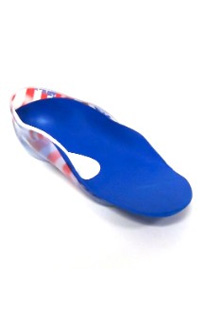 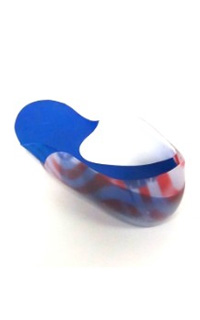 |
|
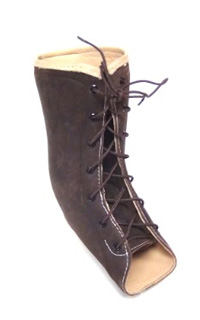 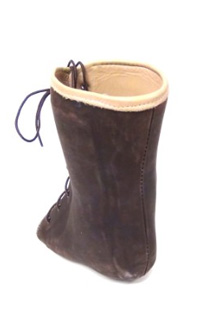 |
Leather Ankle Gauntlet (Arizona AFO)
This custom-molded Leather Ankle Gauntlet is commonly prescribed to treat PTTD, talocalcaneal varus/valgus, tibialis tendonitis, pes planus, ankle arthritis, DJD, charcot, and more. This AFO is designed to stabilize the ankle, increase medial/lateral stability, and can reduce forefoot ab/adduction. The overall height of this brace is shorter than that of most other AFOs, while the layers of leather and reinforcements built into the brace can be somewhat bulky. The entire inside of this brace is lined with a supple leather, while the outside is lined with a more heavy-duty leather. The closure system may involve shoelaces, speedlaces, Velcro straps, or any combination thereof. This brace is worn inside of a shoe, which may require a larger size or extra depth shoe. |
|
Shoe Lift
A shoe lift is the addition of crepe (soling material) to a shoe for the purpose of increasing the shoe's overall height or to wedge the shoe in some direction. There are two types of lift; a removable lift that fits inside the shoe, under the insert and a lift that is actually attached to the outsole of the shoe. Shoe lifts are used in the treatment of leg-length discrepancy (LLD), or to increase the roll of the shoe in patients with limited ankle movement due to a brace or otherwise. Shoe lifts may also be wedged medially/laterally to correct inversion/eversion of the foot or uneven wearing of the sole or they may be wedged heel-to-toe to accommodate a flexion contracture. While most shoes can accommodate the addition of a shoe lift, some cannot. |
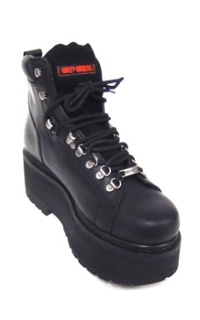 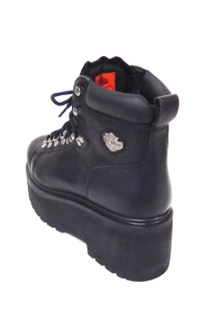 |
|
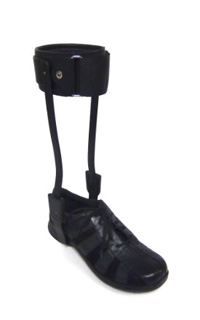 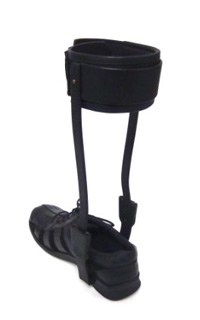 |
Double Action Double Upright AFO (DUAFO)
There are many different designs of DUAFO. The standard DUAFO design consists of two metal uprights (aluminum or steel) attached to a stirrup (solid or split) which is attached to the sole of a shoe. On the proximal end, an aluminum calf band connects both uprights and a padded leather strap secures the brace against your leg. A leather T-Strap may be added to pull the ankle medially/laterally to correct varus/valgus. All leather components can be made to closely match the attached shoe and metal components can be powdercoated almost any color, or simply polished. In the Double Action DUAFO a 2 channel ankle joint allows for more customization than any other DUAFO. With different combinations of pins and springs, or the lack thereof, this brace can achieve free motion, dorsiflexion assist, limited motion, plantar/dorsiflexion stop to any degree and more. However, Klenzak joints can achieve greater dorsiflexion assist due to longer springs, and the steel double action joint heads of this design can cause this brace to be heavier than other designs. |
|
Single Upright AFO (SUAFO)
We find that this design is underutilized in many practices. There are many patients with chronic foot conditions that could benefit from this design. Patients with end stage posterior tibial tendon dysfunction or rupture that has resulted in midfoot collapse, talo-calcaneal valgus and equinus. Also, patients with deformity from charcot joint affecting the ankle or midfoot. These deformities are difficult to treat in a rigid plastic orthosis that fits into a shoe. By combining a custom FO with a medial T-strap, glued or sewn onto the medial aspect of the insert, a very dynamic system is created. Simply by adjusting the tightness of the T-strap the support can be increased or decreased. Leverage is gained from the T-strap crossing over the lateral upright. This design is usually attached to a shoe with a caliper plate for ease of transfer. |
 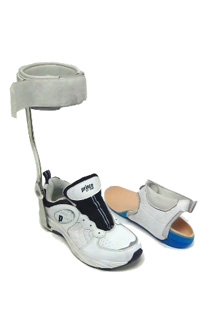 |
| (If you do not see a Product you are looking for, please Contact Us for more information) |
|